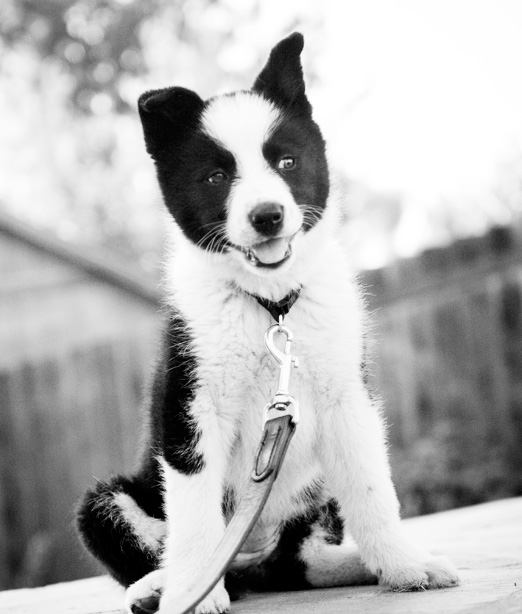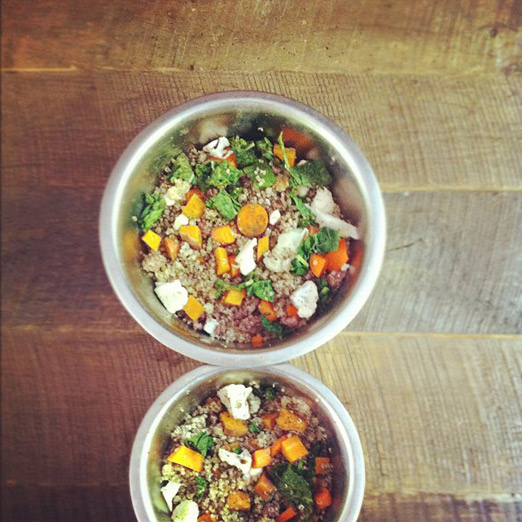
Sorry for the radio silence on the ASK SARAH posts, I so appreciate your emails/questions and have so many I’m looking forward to answering! Keep em coming. I got today’s question a few times and it’s something I feel strongly about, so read on my friends…
Question: Hi Sarah, would you be willing to share your dog food recipe and your rationale for making dog food from scratch? We feed our cat Newman’s Own and are soon getting a rescue dog. I want to do right by them!
Answer: Hi Rocio! Congrats on your new family member and I think it’s so fantastic that you’re rescuing a dog. Three cheers for you! Here are my thoughts on dog food: When Bean first joined me I knew almost nothing about nutrition, but I knew that dog foods are notoriously poor in quality (it’s SCARY the things that they sneak into pet food) so I invested in the best quality kibble I could find. This site is a great source for comparing dog food brands. I have always fed my pets Orijen it gets great reviews and was recommended to me by a few people I trust. But Bean was never really into kibble. She would eat a little, then spend 5 minutes pushing it around with her snout and whining. I was constantly worried that she wasn’t eating enough. Plus, she’s naturally kate-moss thin, so it was a concern. Then when I got sick and started to learn more about nutrition I re-thought EVERYTHING.
I read The China Study and it was a major awakening (highly, highly, highly recommend you get this book). It discusses a huge study that was done on mice/rats concerning diet. In summary they found that increasing animal protein in the diet of the mice/rats increased cancer cell growth and putting the mice/rats on a vegan diet brought cancer cell growth to a halt. This applied to all sorts of modern illnesses, not just cancer. It forever changed my ideas about food.
After that I decided that I couldn’t feed the dogs plain old kibble anymore. But finding a definitive answer on what dogs need for health is like searching for a needle on the interweb. Everyone has an opinion. So, I trust my gut and after a little over a year of feeding the dogs this way and tweaking it based on watching them, this is how I feed them:

Every few days I make a giant batch of quinoa (2 cups dry) and a giant batch of veggies. It’s important to research what dogs and cats are allergic to before going down this road. Feeding them onions or grapes, for instance, could make them very ill or possibly even kill them. I feed them the following veggies in abundance: sweet potato, squash (all varieties), pumpkin, carrots, broccoli, cauliflower, turnips, potatoes, corn, kale, snap peas, green beans, cucumber (and the occasional apple or banana!). I try to feed them whatever seasonal veggies we’re eating, but sweet potatoes are a star player always. Lots of times they get the veggies that have gotten a little ripe for my liking. I mix the veggies with quinoa, a tablespoon or so of olive oil, 1/3 cup of dry Orjen fish kibble for Bean and half that amount for Ellie, 1 tsp of pet kelp
supplement, and each starts the meal with 1/2 sheet of nori (seaweed). The LOVE it. Bean scarfs down every meal. This pooch who turned her nose at bowls full of kibble with peanut butter mixed in as a bribe eats her dinner like a champ. It took me a few tries to figure out how much they each need, based on their bathroom trips. My first instinct was to was over feed them which resulted in lots of trips outside in the middle of the night.
I also give them beef marrow bones- I will let them chew for 15 minutes or so then take them away so they last longer. These are great because they help clean their teeth. And every once in awhile I’ll splurge on some grass fed organic bison and cook that up for them. A small package lasts an entire week with how little I give them.
Now, is all of this sounding like a ton of work to you? Well, it’s not as easy as scooping kibble out of a bin, but it’s not incredibly hard either. It’s a matter of chopping up some veggies (i steam some & serve some raw) and cooking some quinoa. It lasts for a few days and then I have to do it again. It’s more work, but the idea that food is supposed to be zero effort is part of the problem we’re facing in this world- eating things that bear no resemblance to what grows out of the ground is at fault for so many illnesses and the cause of so much suffering. So yes, this is more effort but worth every bit of it. And yes, it’s also more expensive (everything they eat is organic), although I think I’ll get that back in the end with far fewer vet bills. I believe in spending more for quality when it comes to food- the idea being we’ll get paid back with good health and quality of life.
I have a friend whose dog was terribly overweight, lethargic and old beyond her years. At his house one night I got into a discussion with him and found out she was only eating 1 cup of kibble a day! It seemed crazy that she would be so overweight and uncomfortable. So he decided to try this way of feeding and said he noticed an immediate change. She used to wander begrudgingly over to her dog bowl to eat her kibble, sometimes he would even have to call her over. Then when he started preparing meals for her she started doing happy jumping dances in the kitchen while he was putting it together! She LOVED it and there’s no going back for the two of them. And the best part, she’s lost weight, has more energy, and is much much happier. She’s a true success story. If there were a Richard Simmons for dogs, she’d be all over it.
I hope all of this helps! Anyone else care to weigh in on this one? Would love to hear!!
*photo one of Bean from the day she came to live with me and photo 2 of the dogs breakfast (they get this once a day and wag their tails and prance around the kitchen while i’m making it)


Sarah, Could you give the name of the site that compares the quality of dog kibbles.
Hi Sharon, here it is: http://www.dogfoodadvisor.com/dog-food-reviews/brand/
This is great, Sarah. Thanks so much for sharing! This year I changed my eating habbits too by trying to eliminate all toxins by eating only organic, and no processed foods, just whole fruits and lots of vegetables and NO meat or grains/gluten whatsoever. I have noticed such a big difference in my health I switched my Coco Bean over to a grain-free dog food and have started adding in raw + cooked veggies and fruits. She is in love with carrots and blueberries, its hilarious! I even started adding flaxseed oil + probiotics into her dishes. Ever since then her allergies and itchiness have completely vanished, and she seems to have so much more energy. She has to be happier now that she isn't scratching and sneezing all the time. I will have to check out The China Study! I have been watching so many documentaries on food and meat lately. So scary, and reaffirms my decision even more. I'm never going back and neither is Coco Bean!
So happy Ruca Bean is happy & heathly
Sarah
Chicsprinkles.com
Wow, this is super interesting to read and I'm so glad you shared the details. I would never have thought that a dog would be so into quinoa!
I just have to add my personal experience with my cat and Orijen. I had my cat on it for a couple of years after I moved to a new town and was forced to change her kibble. I chose it because it seemed to be the greenest and most natural, and also because it's relatively locally made (I'm in Montreal, and Orijen is from Alberta). However it didn't work well for my older cat. Orijen attempts to recreate the nutritional components of what cats would eat in the wild – so an ENORMOUS amount of protein. It caused my older, low-activity cat to gain a lot of weight. I switched her to a good quality "senior" kibble last year and she's been much healthier on it.
I am definitely not an expert and I'm sure Orijen is great for many pets, but just wanted to share my experience – amazing how much eating habits can be different from one small creature to the next!
My parents went through a really similar situation with our rescue dog. She had terrible allergies, would pick at her dog food and then try to eat ours, was taking horrible steroids that made her feel bad. She spent so much time curled up feeling sorry for herself.
After feeling torn for so long my mum started cooking meals for her from scratch and we noticed the exact same change. She was more energetic, happy, and the allergies went away. She does still eat meat but man does that dog eat better than we do.
Never again would I feed a pet premade pet food.
oh my gosh ya'll, i am so glad to hear that you've been able to help your pets! all of this makes me feel even better about my high maintenance food strategy. seriously though, i know that feeding dogs this way HAS to be better than highly processed kibble, but it's still a little scary venturing into the unknown when it comes to their dietary needs. i am so happy to hear it's been working so well for you furry families too! and @christine i'm glad that switching kibble helped but i can't help but wonder if they wouldn't be better off eating a more natural diet? i have zero knowledge about what cat needs are, but i'd be curious to look into it!
seriously though, i know that feeding dogs this way HAS to be better than highly processed kibble, but it's still a little scary venturing into the unknown when it comes to their dietary needs. i am so happy to hear it's been working so well for you furry families too! and @christine i'm glad that switching kibble helped but i can't help but wonder if they wouldn't be better off eating a more natural diet? i have zero knowledge about what cat needs are, but i'd be curious to look into it!
Sarah, I know I'm super behind on responding to this, but I'm thinking about trying to mix things up and include this method with our current bag of kibble (Wellness Core, another great company recommended by Dog Food Advisor). Can you include the weights for Bean and Ellie and about how much you are giving them. I have two dogs that are 16 and 22 (should be 19) in my family. The last thing I want to do is overfeed.